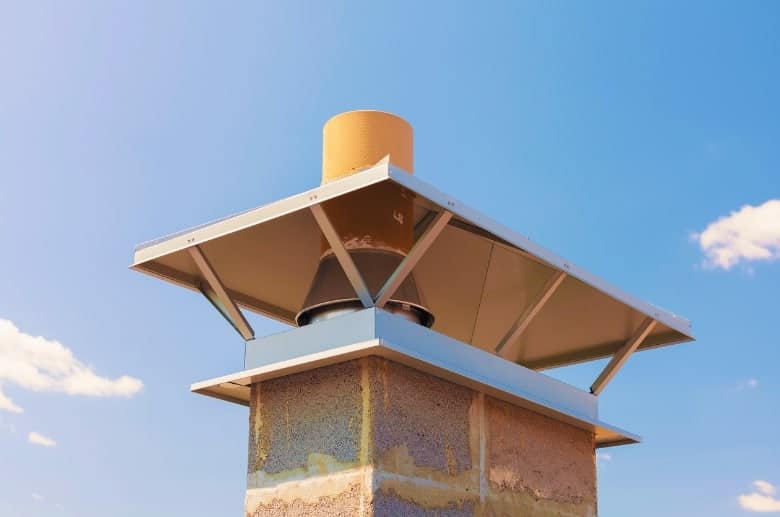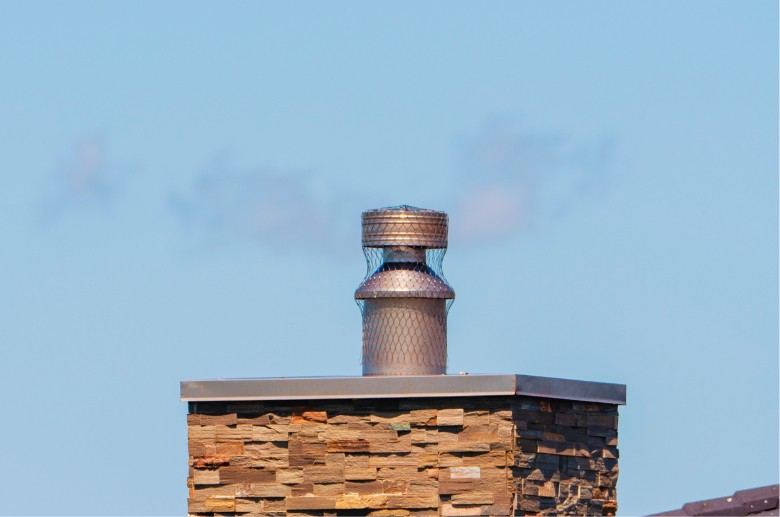Did you know that according to the National Fire Protection Association, heating equipment, including chimneys, caused an estimated 44,210 home fires and 480 deaths in the United States in 2020 alone? We want to ensure you don’t end up in the next statistics!
Chimneys are vital in keeping your home and family safe, so understanding the differences between a chimney chase cover vs crown is important. Both of them are essential components of a chimney system, and each plays a unique role in keeping your chimney functioning properly.
What are the Differences Between a Chimney Chase Cover and a Crown?
Before we dive into the eight major differences, let’s take a quick look at each component and why they are necessary.
Chimney Chase Cover

A chimney chase cover is a metal cap that covers the top of a chimney chase. It’s a structure that surrounds and protects a factory-built chimney pipe. The purpose of a chimney chase cover is to prevent water, debris, and animals from entering the chimney chase and causing damage to the chimney system or home.
Chimney chase covers are typically installed by sliding them over the wood frame chimney chase’s top and securing them with screws or other fasteners. The most common materials for chimney chase covers are galvanized steel, stainless steel, and copper. These materials are durable and corrosion-resistant, ensuring the chimney chase cover lasts many years.
The benefits of a chimney chase cover include:
- Protection against water damage: A chimney chase cover prevents leaking issues and other moisture from entering the chimney chase.
- Prevention of debris buildup: The chimney chase cover prevents leaves, twigs, and other debris from obstructing the chimney system.
- Protection against animal intrusion: A chimney chase cover can also keep animals such as birds, squirrels, and raccoons from entering the chimney and nesting inside.
Common issues that can arise with a chimney chase cover include:
- Rust: Chimney chase covers made of galvanized steel may rust over time, leading to corrosion and eventually damaging the chimney system.
- Damage: Heavy winds, hail, and falling tree limbs can damage a chimney chase cover, making it less effective at protecting the chimney.
- Poor installation: Improper installation can cause it to shift or become loose, allowing water and debris to enter the system.
It’s important to choose a high-quality cover made of durable materials and to have it installed correctly to ensure it provides optimal protection for your home.
——
Do You Need to Hire Chimney & Fireplace Expert?
Get free quotes from qualified experts near you. No commitment required!
——
Chimney Crown

A chimney crown is a masonry cap that sits at the top of a chimney to protect it from the elements. It extends a few inches beyond the chimney’s edge to direct water away from the structure.
A chimney crown is installed on top of the chimney, typically made of concrete or mortar, and constructed in a sloping shape to help water runoff. The installation involves preparing the chimney’s top surface by removing any loose or damaged materials and then applying a layer of mortar. Once the mortar has set, the crown is constructed on top of the mortar layer.
Some benefits of a chimney crown include:
- Protection from water damage: The primary purpose of a chimney crown is to protect the structure from water damage.
- Increased longevity: A well-designed and properly installed chimney crown can extend the life of a chimney, helping it last for decades.
- Preventing animal entry: A well-built crown can also help prevent animals from entering the chimney, which can cause blockages and other issues.
However, some common issues can arise with a chimney crown:
- Cracking: Concrete or mortar crowns can crack over time due to freeze-thaw cycles, settlement, or other factors.
- Water damage: Water can penetrate and damage the chimney structure if the crown is not properly installed or maintained.
- Poor construction: A poorly designed or constructed crown can lead to water penetration, animal entry, or other problems.
Regular chimney inspections and crown maintenance are crucial to ensure the proper functioning and longevity of a well-designed and installed chimney crown.
Chimney Chase Cover vs Crown Comparison
Although both of these chimney components have similar purposes—to protect the chimney from water damage, debris, and animal intrusion—there are some key differences between them.
The chimney chase cover is a metal covering that sits over the top of a prefabricated or factory-built chimney chase, while the chimney crown is a masonry slab that sits on top of a masonry chimney.
Here’s a comparison between the chimney chase cover vs crown:
| Features | Chimney Chase Cover | Chimney Crown |
| Function and purpose | To protect a prefabricated or factory-built chimney chase from water and debris. | To protect the masonry chimney from water and debris. |
| Material | Typically made of metal, such as stainless steel, copper, or aluminum. | Made of concrete, stone, or mortar. |
| Installation process | Easy and straightforward, it can be installed by a professional or as a DIY project. | Requires professional installation, as it involves the use of masonry materials. |
| Durability and lifespan | It usually lasts 15-20 years, depending on the material used. | It can last several decades, even up to 50 years, with proper maintenance. |
| Cost | The average cost is between $1000 – $3500 or more. | It can be more expensive than a chimney chase cover, especially if custom work is required. |
| Aesthetic appeal | It can be unsightly due to the metal material. However, it can be painted or finished to blend in with the roof. | Can add to the overall appearance of the chimney and house. |
| Maintenance requirements | Low maintenance, occasional cleaning, and inspection are needed. | Regular maintenance and inspection are needed to prevent cracking and water damage. |
| Complexity of repair | Easy to replace or repair if damaged. | More complex to repair and may require professional assistance. |
Function and Purpose
A chimney chase cover and a crown serve different functions and purposes when protecting and maintaining the chimney.
- Chimney Chase Cover: The main function of a chase cover is to prevent water, debris, and animals from entering the chimney system. It acts as a protective barrier and helps keep the chimney dry and free from damage.
- Chimney Crown: The primary purpose of a chimney crown is to protect the chimney from water damage by directing water away from the flue opening. It also helps prevent the deterioration of the chimney structure by providing a barrier against external elements.
Material
Chimney chase covers, and chimney crowns differ in the materials used for their construction.
- Chimney Chase Cover: Chase covers are typically made of metal, such as stainless steel, aluminum, or galvanized steel. These materials are chosen for their durability and resistance to corrosion.
- Chimney Crown: Chimney crowns are usually made of masonry or concrete. They are built on-site by skilled masons using mortar and concrete mixtures. The materials used in chimney crowns are selected for their ability to withstand weather conditions and provide long-term protection.
Installation Process
The installation processes for chimney chase covers and chimney crowns also differ.

- Chimney Chase Cover: Installing a chase cover involves measuring the dimensions of the chimney chase and ordering a custom-fit cover. Once the cover is ready, it is positioned and secured over the chimney chase using screws or other fasteners. Proper sealing and flashing are crucial to ensure a watertight installation.
- Chimney Crown: Constructing a chimney crown requires skilled masonry work. It involves building a form to shape the crown, pouring and shaping the concrete or mortar mixture, and allowing it to cure. To ensure water runoff, the crown must be correctly sloped away from the flue opening.
——
Do You Need to Hire Chimney & Fireplace Expert?
Get free quotes from qualified experts near you. No commitment required!
——
Durability and Lifespan
Chimney chase covers and chimney crowns differ in durability and lifespan.
- Chimney Chase Cover: Metal chimney chase covers are generally durable and can withstand exposure to the elements. Stainless steel covers offer the highest durability and longevity, often lasting for several decades. However, over time, the metal can rust or corrode, especially in areas with harsh weather conditions or high levels of moisture.
- Chimney Crown: Well-constructed chimney crowns using high-quality materials can have a long lifespan. However, metal chase covers may be more prone to cracking and deterioration. Proper maintenance and regular inspections are essential to identify and repair any damage to ensure the crown’s longevity.
Cost
The cost of chimney chase covers, and crowns varies based on several factors.
- Chimney Chase Cover: Metal chase covers are generally more affordable compared to chimney crowns. The cost depends on factors such as the size of the chimney chase, material used, and any customization required.
- Chimney Crown: Chimney crowns, being a masonry structure, are typically more expensive than chase covers. The cost is influenced by the size, complexity of design, materials used, and labor required for construction.
Aesthetic Appeal
Chimney chase covers and chimney crowns also differ in aesthetic appeal.

- Chimney Chase Cover: Chase covers, made of metal, have a sleek and modern appearance. They can be customized with different finishes and designs to match the overall aesthetic of the building or roofline.
- Chimney Crown: Chimney crowns, made of masonry or concrete, have a more traditional and rustic look. They are often designed to blend with the chimney’s masonry construction and the overall architectural style of the building.
The choice between the two depends on various factors, including personal preference, budget, and specific requirements for chimney protection and aesthetics.
Maintenance and Repair Tips
Proper maintenance and repair of chimney chase covers and crowns are essential to ensure their longevity and prevent damage to the chimney and the house. Here are some tips for maintaining and repairing both chimney chase covers and crowns:
- Regular Inspection: Inspect the chimney chase cover or crown regularly for any signs of damage, such as cracks or rust. Address any issues immediately to prevent further damage.
- Cleaning: Clean the chimney chase cover or crown regularly to remove any debris, leaves, or other materials that may accumulate on it. Use a soft brush or a leaf blower to remove the debris.
- Sealing: Apply a waterproof sealant to the chimney chase cover or crown to prevent water damage. This will help to protect the chimney and prevent any leaks.
- Professional Inspection: Have a professional inspect the chimney and the chase cover or crown at least once a year. A professional can identify any potential issues and recommend repairs or replacements as necessary.
- Prompt Repairs: Promptly address any issues with the chimney chase cover or crown to prevent further damage. Repair or replace the chimney chase cover or crown immediately to prevent water damage and costly repairs.
We recommend having your chimney inspected annually, and the chimney chase cover or crown maintained and repaired regularly to ensure it’s functioning and to prevent any damage.
Conclusion
Although both chimney chase covers and crowns are designed to protect the chimney from water damage, debris, and animal intrusion, they have some key differences.
Chimney chase covers are made of metal and commonly used with prefabricated or factory-built chimneys. On the other hand, chimney crowns are specifically designed for masonry chimneys and require specialized knowledge for installation and maintenance.
We highly advise scheduling an annual chimney inspection and regular maintenance and repairs of the chase cover or crown to ensure it functions properly.






